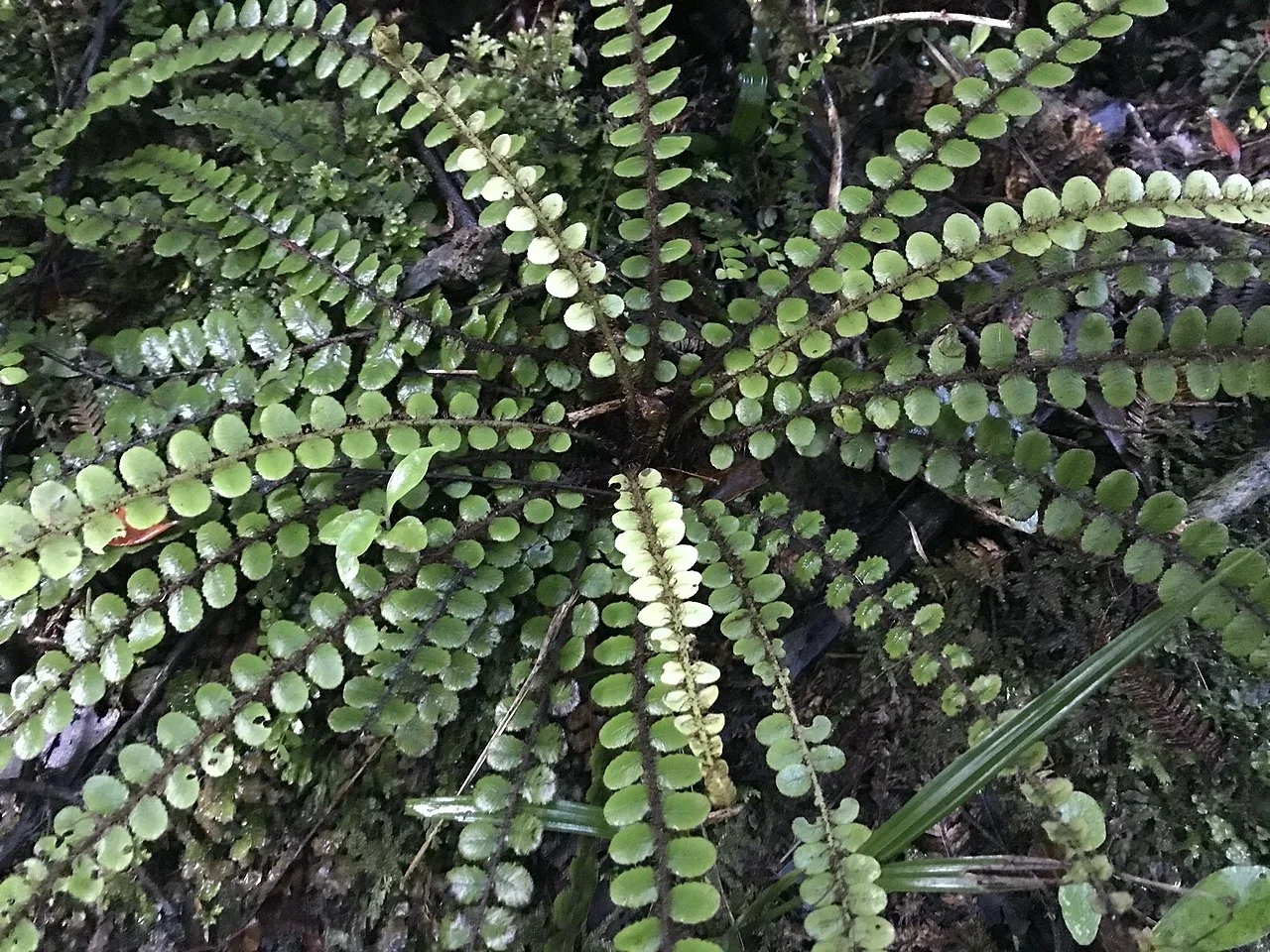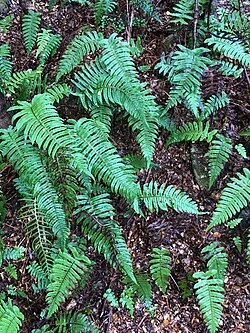
River Fern
Cranfillia fluviatilis
Introduction
Introduction Overview
The River Fern ( Cranfillia fluviatilis ) is a distinctive native fern found throughout New Zealand. This species is characterized by its unique frond structure and preference for moist, shaded environments. The fern 's name reflects its habitat preference, as it's commonly found along riverbanks and in damp forest areas. This fern is part of the Blechnaceae family and was previously classified as Blechnum fluviatile . It's a valuable component of New Zealand's native forest ecosystems, providing habitat for various wildlife and contributing to the biodiversity of riparian zones, including native ferns and other wetland plants . native ferns.

Plant Description
Botanical Features
Cranfillia fluviatilis , also known as River Fern, Kiwikiwi, or Creek Fern (formerly Blechnum fluviatile ), is a distinctive species of "hard fern" native to New Zealand and southeast Australia. It is characterized by its ground-hugging rosette shape, with ladder-like fronds that can reach up to 50 cm in length. The fertile fronds are dark brown and spiky, standing upright from the center of the plant, while the drooping sterile fronds, with their nearly round leaflets, form the rosette. As the plant ages, it develops a short trunk central to a surrounding colony. This hardy fern thrives in moist, shaded conditions, commonly found in damp, shady areas with acidic, moist, and boggy soil, particularly beside streams in forest areas.
Quick Facts
Quick Facts Overview
| Scientific Name | Cranfillia Fluviatilis |
|---|---|
| Height | 30-60 cm |
| Spread | 30-50 cm |
| Water Needs | High; requires consistent moisture |
| Light | Partial to full shade |
| Frost Tolerance | Moderate |
| Salt Tolerance | Low |
| Growth Rate | Slow to moderate |
| Lifespan | Long-lived perennial |
Climate Best Suited to
River Fern is found throughout New Zealand in moist, shaded environments. It thrives in areas with high humidity and consistent rainfall, particularly in forest understories and along riverbanks.
Regional Suitability
| City | Climate Suitability |
|---|---|
| Whangārei | Ideal |
| Auckland | Ideal |
| Hamilton | Ideal |
| Tauranga | Ideal |
| Rotorua | Ideal |
| Gisborne | Ideal |
| New Plymouth | Ideal |
| Napier | Ideal |
| Whanganui | Ideal |
| Palmerston North | Ideal |
| Wellington | Ideal |
| Nelson | Ideal |
| Christchurch | Ideal |
| Dunedin | Ideal |
| Invercargill | Ideal |
Plant Habitat
Plant Habitat Overview
River Fern is naturally found in moist, shaded environments throughout New Zealand, particularly along riverbanks, in damp forest understories, and in riparian zones. It thrives in areas with high humidity and consistent moisture, often growing in association with other native ferns and moisture-loving plants. The fern 's natural habitat includes forest margins, stream banks, and damp gullies where it contributes to the biodiversity of these important ecosystems.
Plant Conservation
The fern Cranfillia fluviatilis , also known as kiwikiwi or creek fern, has a conservation status of "Not Threatened" as of 2017, by the NZPCN. This status has been consistent since at least 2004. It is a native, non-endemic vascular fern found in New Zealand and southeast Australia. It thrives in moist, shaded conditions, often found in damp areas near streams in forest environments.
Growing Requirements
Soil Requirements
Cranfillia fluviatilis prefers moist, well-draining soils rich in organic matter. It thrives in humus-rich forest soils and can tolerate a range of soil types from sandy loam to clay, as long as moisture is maintained.
Light Requirements
This fern prefers partial to full shade, thriving in the understory of native forests. It can tolerate some filtered sunlight but should be protected from direct afternoon sun, especially in warmer regions.
Water Requirements
Cranfillia fluviatilis requires consistent moisture and high humidity. It's naturally found in damp environments and needs regular watering to maintain soil moisture, especially during dry periods.
Natural Habitat
Geographic Distribution
Plant in moist, shaded locations with well-draining soil rich in organic matter. Prepare the site by removing competing vegetation and improving soil structure. Plant at the same depth as the original container and water thoroughly after planting.
Ecological Role
Wildlife Interactions
River Fern plays an important ecological role in New Zealand's native ecosystems. It provides habitat and food for native wildlife and contributes to ecosystem health and biodiversity.
Uses and Significance
Cranfillia fluviatilis , commonly known as kiwikiwi, kiwakiwa, or creek fern, is a decorative hard fern native to New Zealand and parts of coastal southeast Australia.
Uses:
- Ornamental and Ground Cover: It is a beautiful species with a low spreading habit, making it easily cultivated as an excellent ground cover in gardens. It is well-suited for group plantings to enhance landscape aesthetics.
- Riparian Plantings: Due to its natural habitat beside streams and in damp, boggy soil, it is used in riparian plantings.
- Forests: It is also utilized in forest environments.
- Container Plant/Houseplant: It can be grown as a container plant or houseplant, and is considered tropical-looking for woodland gardens.
Significance:
- Ecological Role: Cranfillia fluviatilis thrives in moist, shaded conditions, often found in acidic, moist, and boggy soil near streams in forest areas. Its presence contributes to the biodiversity of these ecosystems. It is considered a native vascular fern in New Zealand and is currently classified as "Not Threatened."
- Hardy and Adaptable: This fern is hardy and easily cultivated, adapting well to various garden environments as long as a protected, moist spot is provided.
- Distinctive Appearance: It is characterized by its low spreading habit, erect rhizome structure, and ladder-like fronds up to 50 cm long. Its fertile fronds are dark brown and spiky, standing upright from the center, while the drooping sterile fronds form a ground-hugging rosette.
Landscaping Uses
Landscaping Uses Overview
River Fern is highly valued in landscaping for its aesthetic appeal and practical benefits. It can be used in various garden styles and landscape applications.
Seasonal Care Calendar
Seasonal Care Calendar Overview
Spring care involves removing old fronds and ensuring adequate moisture. Summer maintenance focuses on maintaining humidity and protecting from drought. Autumn preparation includes mulching to retain moisture. Winter care involves protecting from frost in exposed locations.
When to Prune and How Much
When to Prune and How Much Overview
Remove dead or damaged fronds as needed throughout the year. Prune old fronds in spring to encourage new growth. Avoid removing more than one-third of the foliage at any time. Use clean , sharp tools to prevent disease transmission.
How to Grow River Fern
The River Fern is a beautiful and delicate native fern that thrives in moist, shaded environments, making it an excellent choice for woodland gardens, ferneries, or alongside water features. Its distinctive fronds and preference for damp conditions make it a valuable addition to native plant collections, contributing to the biodiversity of riparian zones. While it requires consistent moisture and protection from direct sun, its unique beauty and ecological role make it a rewarding plant to cultivate.
From Spores
Propagating ferns from spores is a fascinating process, though it requires patience and specific conditions. Collect mature spores from the undersides of healthy fronds when they are dark brown and easily dislodge. Sow the spores onto a sterile, moist substrate, such as peat or a specialized fern-growing medium, in a sealed container to maintain high humidity. Keep the container in a warm, dimly lit location. Germination can take several weeks to months, forming a green, moss-like prothallus. Eventually, tiny fern sporophytes will emerge. Once they are large enough to handle, transplant them into individual pots and gradually acclimate them to lower humidity before planting out.
From Division
Division is a simpler and more reliable method for propagating established River Fern clumps. This is best done in spring when new growth is emerging. Carefully dig up the entire fern clump, or a section of it, using a sharp spade. Gently separate the rhizomes into smaller sections, ensuring each division has a healthy portion of roots and several fronds. Replant the divisions immediately into well-prepared soil that is rich in organic matter and consistently moist. Water thoroughly after planting and keep the newly divided ferns well-watered and protected from direct sun until they are established.
Pests and Diseases
Pests and Diseases Overview
Generally pest -resistant but can be affected by scale insects and mealybugs. Root rot can occur in poorly drained soils. Monitor for common fern pests and treat promptly if infestations occur. Ensure good air circulation to prevent fungal issues.
Cultural Significance
Traditional Uses and Values
The fern Cranfillia fluviatilis , also known by its Māori names kiwikiwi or kiwakiwa, holds cultural significance primarily through its traditional medicinal uses by the Māori people of New Zealand.
Historically, the fern was utilized for its therapeutic properties. It was chewed as a remedy for ulceration or soreness of the mouth and tongue. Additionally, crushed fronds of Cranfillia fluviatilis were applied to breasts to impart a bitter taste, a practice employed during the weaning process.
Bonus Tip
Expert Growing Advice
The River Fern ( Cranfillia fluviatilis ) is a fantastic choice for creating a naturalistic, layered effect in a shaded garden. Its unique growth habit, forming a ground-hugging rosette of sterile fronds with upright, spiky fertile fronds emerging from the center, provides excellent textural contrast. Plant it in groups along the edges of paths, at the base of larger ferns or trees, or beside a water feature to highlight its distinctive form. Ensure consistent moisture and protection from direct sun to help it thrive and create a lush, tranquil understorey.







